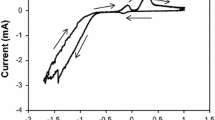Abstract
Electrochemically deposited permalloy based NiFe/Cu multilayers, relating their magnetic and magnetoresistance properties with crystal structure and the corresponding film composition were studied as a function of the total film thickness. The permalloy based multilayers were grown on strong (110) textured copper sheets with electrodeposition under potentiostatic control. The total multilayer film thickness was changed from 0.3 to 5 µm while ferromagnetic nickel–iron and nonmagnetic copper layer thickness was kept constant at 3 and 1 nm, respectively. Energy dispersive X-ray analysis revealed that the nickel and iron content of the multilayers decreased and copper content increased as the total film thickness increased. All multilayers exhibited face-centred cubic structure with (110) preferred orientation. The highest peak intensity changed from (220) to (111) when the total thickness was higher than 2 µm. The multilayers exhibited giant magnetoresistance (GMR). The maximum GMR magnitude of ~4 % was obtained for the films with total thickness less than 1 µm and the GMR decreased down to ~1 % with increasing film thickness to 5 µm. The saturation magnetisation and coercivity decreased from 78 to 11 emu/cm3 and from 24 to 12 Oe as the total thickness of the multilayers increased from 0.3 to 5 µm, respectively. The variations in magnetic and magnetoresistive properties related to the microstructure were attributed to the variation of the film contents caused by total film thickness.





Similar content being viewed by others
References
S.M.S.I. Dulal, E.A. Charles, S. Roy, Electrochim. Acta 49, 2041–2049 (2004)
C.B. Ene, G. Schmitz, R. Kirchheim, A. Hütten, Acta Mater. 53(12), 3383–3393 (2005)
M. Djamal, A. Ramli, Procedia Eng 32, 60–68 (2012)
G. Nabiyouni, W. Schwarzacher, J. Cryst. Growth 275, 1259–1262 (2005)
J. Gong, W.H. Butler, G. Zangari, IEEE Trans. Magn. 41(10), 3634–3636 (2005)
I. Bakonyi, L. Peter, Prog. Mater Sci. 55, 107–245 (2010)
J. Kanak, T. Stobiecki, P. Wiśniowski, G. Gladyszewski, W. Maass, B. Szymański, J. Magn. Magn. Mater. 239, 329–331 (2002)
K. Attenborough, R. Hart, S.J. Lane, M. Alper, W. Schwarzacher, J. Magn. Magn. Mater. 148, 335–336 (1995)
E. Chassaing, P. Nallet, M.F. Trichet, J. Electrochem. Soc. 143, 98–100 (1996)
S. Esmaili, M.E. Bahrololoom, K.L. Kavanagh, Mater. Charact. 62, 204–210 (2011)
S. Esmaili, M.E. Bahrololoom, Surf. Eng. Appl. Electrochem. 48, 35–41 (2012)
S. Esmaili, M.E. Bahrololoom, L. Peter, Thin Solid Films 520, 2190–2194 (2012)
M.S. Haciismailoglu, M. Alper, H. Kockar, J. Electrochem. Soc. 157(10), 538–545 (2010)
N.V. Myung, K. Nobe, J. Electrochem. Soc. 148(3), 136–144 (2001)
M. Saitou, W. Oshikawa, M. Mori, A. Makabe, J. Electrochem. Soc. 148, 780–783 (2001)
X. Liu, P. Evans, G. Zangari, J. Magn. Magn. Mater. 226, 2073–2075 (2001)
B.D. Cullity, Elements of X-Ray diffraction (Addison-Wesley Publishing, Reading, 1978)
A. Vicenzo, P.L. Cavallotti, Electrochim. Acta 49, 4079–4089 (2004)
E.Y. Tsymbal, D.G. Pettifor, Solid State Physics, vol. 56 (Academic Press, Waltham, 2001), pp. 113–237
Q. Huang, D.P. Young, E.J. Podlaha, J. Appl. Phys. 94, 1864–1867 (2003)
D. Jiles, Introduction to magnetism and magnetic materials (Chapman and Hall, London, 1996)
Acknowledgments
This work was supported by Balikesir University Research Grant No. BAP 2001/02, 2005/38 for MR system and The State Planning Organization (DPT) under Grant No. 2005K120170 for VSM system, Scientific and Technical Research Council of Turkey (TUBITAK) under Grant No. TBAG-1771 for electrodeposition system. The authors would like to thank Material Science and Engineering Department, Anadolu University, Turkey for the use of XRD and EDX measurements.
Author information
Authors and Affiliations
Corresponding author
Rights and permissions
About this article
Cite this article
Kuru, H., Kockar, H. & Alper, M. A study on total thickness dependency: microstructural, magnetoresistance and magnetic properties of electrochemically deposited permalloy based multilayers. J Mater Sci: Mater Electron 26, 5009–5013 (2015). https://doi.org/10.1007/s10854-015-3014-3
Received:
Accepted:
Published:
Issue Date:
DOI: https://doi.org/10.1007/s10854-015-3014-3




